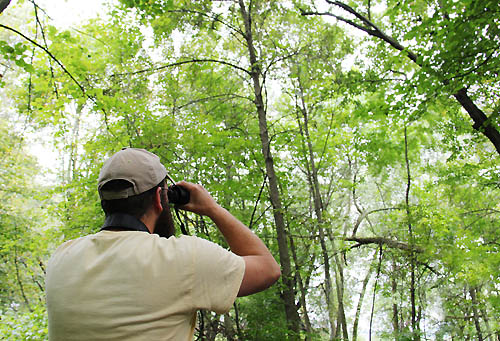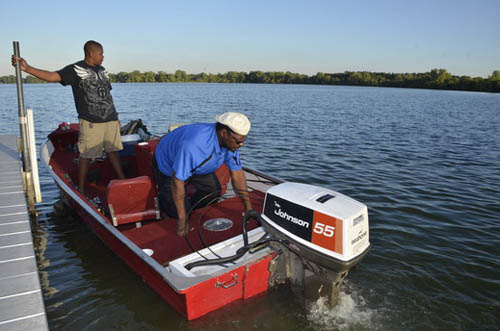Unique water trail, outstanding bird habitat among park’s features
Bird lovers across the Twin Cities are well-familiar with the Rice Creek Chain of Lakes, which boasts some of the most significant migratory bird habitat in the area.
But as important as that is, this water-rich part of the region offers much more.
 An expansive 5,500-acre park reserve is a water lover’s dream. Managed by Anoka County Parks, the reserve includes seven interconnected lakes, headwaters to a 22-mile canoeable waterway to the Mississippi River, a historic learning site, lively nature center, and extensive programming for families and children.
An expansive 5,500-acre park reserve is a water lover’s dream. Managed by Anoka County Parks, the reserve includes seven interconnected lakes, headwaters to a 22-mile canoeable waterway to the Mississippi River, a historic learning site, lively nature center, and extensive programming for families and children.
All that plus swimming, picnicking, camping, hiking, golf, a boat launch and fishing pier — and more.
“Rice Creek offers an extremely wide range of activities to meet the interests and passions expressed by kids, adults, families and seniors alike,” said Andy Soltvedt, Marketing Manager for Anoka County Parks, which owns and operates the Rice Creek Chain of Lakes Park Reserve.
“It’s hard to choose a favorite activity but I do love seeing our 30-foot Voyageur’s Canoe out on the water, loaded with 15 passengers gliding over the water like a vision from the 19th century. It’s one of only two in the region and a neat way to experience the park.”
Council plans and funds parks system with local partners
The Rice Creek Chain of Lakes Park Reserve was added to the Metropolitan Council’s original regional parks system when it was created in 1974. It is the largest park in Anoka County and second-largest in the metropolitan region.
Over the years, the Council has steered $11.1 million of State and Council funds into the park for land acquisition ($4.3 million) and development ($6.8 million), and helping it become one of the most popular parks in the north metro. In 2015, the park had an estimated 418,300 visits.
The Council partners with 10 agencies to plan the outstanding Regional Parks System.
Park is among region’s largest and critical to migrating birds
 Despite its popularity, the park remains mostly undeveloped due to its overwhelming size and function in the regional system — all the better for migratory birds and other wildlife inhabiting the extensive wetlands and heavily forested parklands.
Despite its popularity, the park remains mostly undeveloped due to its overwhelming size and function in the regional system — all the better for migratory birds and other wildlife inhabiting the extensive wetlands and heavily forested parklands.
“The environment is unique to the area and provides critical waterways and habitat for migratory birds traveling through like water fowl, herons, sandhill cranes and other unique bird groups,” Soltvedt said.
“We have a list of very specific bird species seen almost nowhere else around here that attract birders from across the region and beyond. Some of our visitors are very passionate about birding and very active in helping preserve their habitat.”
‘Water trail’ offers canoeists a long day on the water
 Another unique aspect of the park is the headwaters to a 22-mile “water trail.” The trail meanders from Lake Peltier in the park reserve through several lakes and streams from Lino Lakes through Circle Pines, Shoreview and Arden Hills before ending at Manomin Park on the Mississippi River in Fridley.
Another unique aspect of the park is the headwaters to a 22-mile “water trail.” The trail meanders from Lake Peltier in the park reserve through several lakes and streams from Lino Lakes through Circle Pines, Shoreview and Arden Hills before ending at Manomin Park on the Mississippi River in Fridley.
Soltvedt said the water trail is often used for practice by scouting groups and families before venturing to similar water trails in the Boundary Waters Canoe Area. “It’s pretty amazing to have a feature like this so close to a metro area,” he said.
Among its lesser known features, the park is also home to 25 Native American historic sites — including a burial mound. Soltvedt said the area’s abundant resources made it a natural fit for Native Americans for thousands of years, and for early Americans plying the fur trade in the 18th and 19th centuries.
Parks planners will be erecting an interpretive sign near the burial mound this year and more historic signs are forthcoming, but no significant park development is planned.
Maple Syrup Festival brings out spring crowd; more programs on tap
On a cool, cloudy Sunday in March, a few dozen energetic children and adults flocked to Rice Creek to enjoy a rare treat offered in the park every spring: a session on how to make maple syrup the old-fashioned way, based on the practices of Native Americans in this region.
Guided by park volunteers Cody Rosetti and Maria Pierz, visitors learned how they could “tap” Sugar Maples in the park with a steel spigot called a spile and collect the water-like tree sap in a special bucket. They saw how the sap was boiled down at a ratio of 36-to-1 to make delicious and natural pure maple syrup.
Best of all: free samples of the finished syrup over ice cream.
The park offers special programming year-around, from day camps in summer to outdoor survival in winter. Upcoming events focus on birding, spring wildflowers, and rockin’ reptiles. Several family-focused special events are planned for Earth Day on Saturday, April 22.
More information